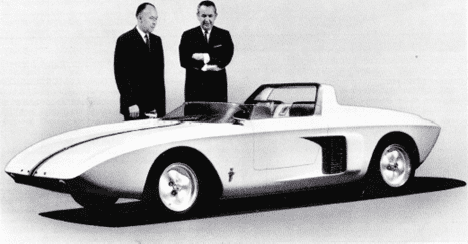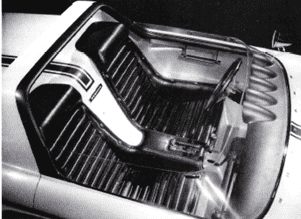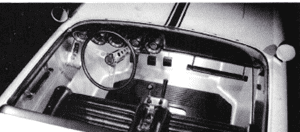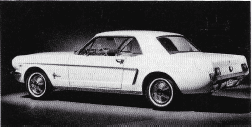Throughout the 20th and 21st centuries, Ford unveiled numerous breathtaking vehicles that introduced important innovations. Although many of these vehicles were available to the public, not every groundbreaking Ford was mass-produced — some never moved past the concept stage. One such stunning car was the 1962 Ford Mustang I concept car.
Although Ford went on to release its historic 1964 ½ Mustang only a couple of years later, many motor enthusiasts have long forgotten its predecessor. Here’s what you need to know about the history and development of this critical entry in automotive history.
Setting the Stage For the 1962 Ford Mustang I
Leading up to the development of the 1962 Mustang I, the American automotive industry had become somewhat stagnant, with few noteworthy innovations in the last decade. There were some notable creations though, such as two impressive concept cars: the Corvette Stingray Racer and Plymouth XNR.
In the early 1960s, Detroit auto manufacturers began developing bucket-seated compact derivatives, moving closer to the contemporary sports car. Some of these compact derivatives included the Corvair Monza, Falcon Futura, and Valiant Signet, all of which sold reasonably well. These vehicles also offered an American alternative to high-quality imported economy cars.
During this time, the Ford Motor Company had a committee made up of Ford managers headed by Lee Iacocca, and this group was called the Fairlane Group. In the summer of 1962, the group decided to begin developing a new sports car. The idea was to create something that was in between Go-Karts and the Chevrolet Corvette.
Although Ford and the committee never mass-produced their stunning sports creation, it laid the foundation for one of the most important cars of all time: the 1964 ½ Mustang.
Development of the 1962 Mustang I
The creation of the 1962 Mustang I can mostly be attributed to the hard work of three men: Herb Misch, Jim Nance, and Eugene Bordinat.
 Herb Misch joined Ford’s team after parting ways with Studebaker-Packard, an automotive company that would go defunct only five years later. The company’s president, Jim Nance, had recently left to run Ford’s subsidiary Edsel, and Misch followed suit. He became the lead engineer working on the Mustang I concept car.
Herb Misch joined Ford’s team after parting ways with Studebaker-Packard, an automotive company that would go defunct only five years later. The company’s president, Jim Nance, had recently left to run Ford’s subsidiary Edsel, and Misch followed suit. He became the lead engineer working on the Mustang I concept car.
The Mustang’s stylist was Eugene Bornidat, who was an integral part of Ford’s subsidiary Mercury. Later in 1962, he became the vice president of styling and a chief designer at Mercury.
In addition to great engineers and stylists, every good car needs a planner who can set objectives and keep the project on track. For the 1962 Mustang I, this was Roy Lunn from Ford’s Product Study Vehicles Department. He had previously worked for the British manufacturer Aston Martin.
The team designed the Mustang I concept car carefully and made sure to avoid creating a vehicle that would compete with the Chevrolet Corvette. Roy Lunn felt that the market for Corvette-esque vehicles was already saturated.
Instead, the team got to work building a prototype from a multi-tubular frame and aluminum body. They enlisted the services of the Los Angeles special builders Trautman and Barnes. The pair built the Mustang I’s frame with one-inch steel tubing and added a stressed-skin aluminum body with a roll bar and seat structure. The vehicle’s rigid seat wasn’t adjustable, but the car’s pedals and steering wheel could be adjusted to accommodate its driver.
Roy Lunn and Herb Misch developed the concept car’s all-wheel independent suspension, which was a groundbreaking innovation for the Ford Motor Company and other Detroit auto manufacturers. The front of the vehicle featured wishbones with Monroe telescopic shocks and splayed-out coil springs, while the rear sported upper wishbones and lower-triangulated arms that were latched to radius rods. The suspension’s attachment points distributed stress evenly. Like the car’s pedals and steering wheel, the car’s shocks and springs could be adjusted.
The Mustang I’s steering utilized the rack and pinion unit that originated from the Ford Cardinal. The steering wheel had 2.9 turns lock-to-lock, and the turning circle had 30 feet.
Specifications of the 1962 Mustang I
 The Mustang I’s similarities to the Ford Cardinal didn’t end with its steering system. Like the Cardinal, the Mustang I featured a rear-mounted powertrain that was ahead of its rear wheels. The car sported a 91 cu in (1.5 L) V4 engine and a single-throat Solex carburetor that could produce 90 horsepower at 6500 revolutions per minute.
The Mustang I’s similarities to the Ford Cardinal didn’t end with its steering system. Like the Cardinal, the Mustang I featured a rear-mounted powertrain that was ahead of its rear wheels. The car sported a 91 cu in (1.5 L) V4 engine and a single-throat Solex carburetor that could produce 90 horsepower at 6500 revolutions per minute.
Ford equipped the concept car’s track version with two double-throat side-draft Webers and a crossover manifold that could produce 100 brake horsepower. The Ford team also bolted a Cardinal transaxle to the engine as well as a 7 ½-inch clutch and a gear change lever that was connected by cables. Two diagonal

ly-mounted radiators cooled the vehicle’s engine with thermostatic fans.
The 1962 Ford Mustang I was 154 inches long and had a 90-inch wheelbase and 48/49-inch (front/rear) track. Because the Ford team utilized a light construction, the car only weighed 1,148 pounds, allowing for quick turns and a 115 mph top speed. The car’s front featured disc brakes while the rear had drum brakes, a common braking setup for sports cars.
The car’s interior styling featured a five-pod gauge arrangement that featured its fuel level, water temperature gauges, speedometer, rev counter, and ammeter.
Finally, the car had a 13-gallon aluminum alloy fuel tank with a quick fill neck, which the development team placed in the car’s forward compartment along with a spare wheel. This stunning design was compliant with both FIA and SCCA sports car regulations.
The Legacy of the 1962 Mustang I
 The Mustang I made its stunning debut at the U.S. Grand Prix at Watkins Glen, New York, in October 1962, where Dan Gurney drove the breathtaking car around the circuit. His drive wowed the crowd as well as Ford’s Lee Iacocca. Unfortunately, Iacocca and others at Ford knew that the car was too innovative and peculiar to mass produce. Instead, the company developed the four-seat Mustang that we’ve all come to know and love.
The Mustang I made its stunning debut at the U.S. Grand Prix at Watkins Glen, New York, in October 1962, where Dan Gurney drove the breathtaking car around the circuit. His drive wowed the crowd as well as Ford’s Lee Iacocca. Unfortunately, Iacocca and others at Ford knew that the car was too innovative and peculiar to mass produce. Instead, the company developed the four-seat Mustang that we’ve all come to know and love.
Although you may not be able to get your hands on the remarkable 1962 Mustang I concept car — the only operational 1962 Ford Mustang I resides in The Henry Ford Museum — you can still find a number of fantastic classic Mustangs on the market.
If you’re looking to protect a classic Ford Mustang or another vehicle, consider Classic Auto Insurance. We offer customizable and affordable policies that can keep your classic beauty on the road for years to come. Ready to learn more? Call us today at 888-901-1338, or you can get an instant quote here.





